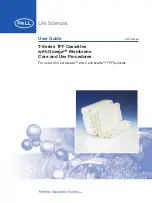
14
a. Ideal
b. Overcompensated
c. Undercompensated
Figure 5.0-4: Measured waveforms
Repeat the above for CH-2.
The amplitude of each signal must be the same. If not, adjust the CH-1
and/or 2 “R” controls to obtain equal signals.
After calibrating each channel individually, invert the CH-2 scope input
and select ADD. The composite waveform should look like that shown in
Figure 5.0-5c. Slight “R” and “C” adjustments may be required to obtain
the best straight line.
a. Unequal amplitude
b. Incorrect compensation c. Optimum differential
Figure 5.0-5: Compensated waveforms
5.3 Testing EIA 541 Voltage Differential
1. Power up all instruments.
Allow at least 15 minutes to warm up.
2. The following initial oscilloscope settings should be used. Follow the
manufacturer's instructions to implement.
a. For normal bag testing, set the scope VERTICAL sensitivities of CH-1
and CH-2 to 50mV. This is equivalent to 50 Volts (100:1 attenuation).
NOTE:
The oscilloscope must have a nominal input impedance of 1
Megohm and 10-20 pF.
b. Set the time base to 1, 2 or 2.5
P
sec.
c. Set CH-2 to INVERT and ADD. This subtracts the lower electrode signal
from the upper electrode signal and results in a single pulse that
represents the actual voltage differential displayed.
NOTE:
The signal
levels of CH-1 and/or CH-2 may exceed the dynamic range of the scope
sensitivity level selected. If this occurs the input amplifier will saturate,








































